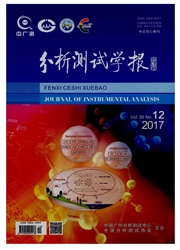

 中文摘要:
中文摘要:
应用可见/短波近红外光谱(Vis/SW-NIRS)测量土壤速效氮(N)和速效钾(K)含量。光谱预处理包括标准正态变换(SNV),多元散射校正(MSC)和Savitzky Golay平滑结合一阶导数,以消除系统噪声和外部干扰,分别应用偏最小二乘(PLS)和最小二乘支持向量机(LS-SVM)方法建立校正模型。最小二乘支持向量机(LS-SVM)输入分别包括主成分分析得到的主成分(PCs)和PLSR建模得到的潜在变量(LVs)和由PLSR模型回归系数得到有效波长(EWs)。结果表明,三种输入的LS-SVM模型都优于PLS模型,其中EWs-LS-SVM模型最佳,速效氮(N)的相关系数(R2)和预测均方误差RMSEP分别0.82和17.2,速效钾(K)为0.72和15.0。结果表明,利用可见光和短波近红外光谱(Vis/SW-近红外光谱)(325~1 075nm)的LS-SVM的结合,可以作为一个精确的土壤理化性质的测定方法。
 英文摘要:
英文摘要:
Visible infrared spectroscopy (Vis/SW-NIRS) was investigated in the present study for measurement accuracy of soil properties,namely, available nitrogen(N) and available potassium(K). Three types of pretreatments including standard normal variate (SNV), multiplicative scattering correction (MSC) and Savitzky-Golay smoothing+first derivative were adopted to elimi- nate the system noises and external disturbances. Then partial least squares (PLS) and least squares-support vector machine (LS-SVM) models analysis were implemented for calibration models. Simultaneously, the performance of least squares-support vector machine (LS-SVM) models was compared with three kinds of inputs, including PCA(PCs), latent variables(LVs), and effective wavelengths (EWs). The results indicated that all LS-SVM models outperformed PLS models. The performance of the model was evaluated by the correlation coefficient (r2) and RMSEP. The optimal EWs-LS-SVM models were achieved, and the correlation coefficient (r2 ) and RMSEP were 0.82 and 17.2 for N and 0.72 and 15.0 for K, respectively. The results indicated that visible and short wave-near infrared spectroscopy (Vis/SW-NIRS)(a25--1 075 urn) combined with LS-SVM could be utilized as a precision method for the determination of soil properties.
 同期刊论文项目
同期刊论文项目
 同项目期刊论文
同项目期刊论文
 Electrochemical reduction of CO2 on modified Cu electrodes resulting frompre-electroreduction anneal
Electrochemical reduction of CO2 on modified Cu electrodes resulting frompre-electroreduction anneal Bi2WO6 micro/nano-structures: Synthesis, modifications and visible-light-driven photocatalytic appli
Bi2WO6 micro/nano-structures: Synthesis, modifications and visible-light-driven photocatalytic appli Construction of 980nm laser-driven dye-sensitized photovoltaic cell with excellent performance for p
Construction of 980nm laser-driven dye-sensitized photovoltaic cell with excellent performance for p Sulfate radical-induced degradation of 2,4,6-trichlorophenol: A de novo formation of chlorinated com
Sulfate radical-induced degradation of 2,4,6-trichlorophenol: A de novo formation of chlorinated com Construction of two Novel 2D Coordination Frameworks with the Ligand H3nbtc:Synthesis, Crystal Struc
Construction of two Novel 2D Coordination Frameworks with the Ligand H3nbtc:Synthesis, Crystal Struc High catalytic Cu electrode for CO2 electroreduction from combined sphericity and nanorod surface st
High catalytic Cu electrode for CO2 electroreduction from combined sphericity and nanorod surface st Experimental measurements of short-term adsorption of Acidithiobacillus ferrooxidans onto chalcopyri
Experimental measurements of short-term adsorption of Acidithiobacillus ferrooxidans onto chalcopyri Surface decoration of Bi2WO6 superstructures with Bi2O3 nanoparticles: an efficient method to improv
Surface decoration of Bi2WO6 superstructures with Bi2O3 nanoparticles: an efficient method to improv A Highly Sensitive Electrochemical Impedance Spectroscopy Immunosensor for Determination of 1-Pyrene
A Highly Sensitive Electrochemical Impedance Spectroscopy Immunosensor for Determination of 1-Pyrene Electrochemical synthesis of silver nanoparticles-coated gold nanoporous film electrode and its appl
Electrochemical synthesis of silver nanoparticles-coated gold nanoporous film electrode and its appl An Immunosensor for Ultrasensitive Detection of 1-Pyrenebutyric Acid with Enhanced Electrochemical P
An Immunosensor for Ultrasensitive Detection of 1-Pyrenebutyric Acid with Enhanced Electrochemical P A highly sensitive differential pulse anodic stripping voltammetry for determination of 17 beta-estr
A highly sensitive differential pulse anodic stripping voltammetry for determination of 17 beta-estr Study on Microwave Irradiated-Voltammetry Synergetic System for the Detection of Trace Pb(II) in Wat
Study on Microwave Irradiated-Voltammetry Synergetic System for the Detection of Trace Pb(II) in Wat 期刊信息
期刊信息
